
|   |

|   |
 e-mail: sunilkothari1933@gmail.com Nrityagram: Homage to Protima Gauri on her death anniversary Photos: Shalini Jain September 4, 2016 Since last four years Nrityagram artists pay homage to Protima Gauri (Bedi) on her death anniversary on 18th August. In order to share with public the various activities and training programs at Nrityagram near Hessaraghatta, some 30 km away from Bangalore, Nrityagram dancers present performances in Bangalore city. Last year was the 25th year of establishment of Nrityagram. Over the years Nrityagram, with Surupa Sen as the choreographer, has been choreographing several dance works, with single minded devotion and dedication. Surupa Sen, Bijayini Satpathy and Pavithra Reddy have won acclaim world over for their performances as classical Odissi dancers. By fortuitous circumstances, I was spending a week at Kula, the special residency block Nrityagram has built, where residencies are held through the year. I was privileged to attend rehearsals for the performances scheduled for 18th August. They were conducted at Odissi Gurukul and Amphitheatre to live music, supervised by Surupa Sen. It gave me an opportunity to assess their progress and see how Surupa and Bijayini have evolved, what we can now call, Nrityagram style of Odissi. Trained by the legendary Guru Kelucharan Mohapatra, Surupa Sen along with Bijayini Satpathy, (she was originally trained at Guru Gangadhar Pradhan's Orissa Dance Academy) took further training in Natyasastra studies, in theory and karana movements under Dr. Padma Subrahmanyam. They were already taking training in yoga and also during Protima's time when she used to arrange workshops of martial arts like Kerala's kalaripayattu. These inputs of yoga, kalaripayattu, Natyasastra studies, and also instructions in medical guidance with regular visits by Dr. Kannan Pugazhendi, a well known doctor of Sports medicine from Chennai, have helped them in evolving their own bani. Regular yoga practice and other physical exercises creating an awareness of maintaining body fitness have helped dancers at Nrityagram immensely to maintain figure and build up stamina. Apart from their national and international tours, these exercises are a daily routine over the past 20 years and more. During my occasional visits and stay at Nrityagram, I have watched their training methodologies and whenever possible, the rehearsals. 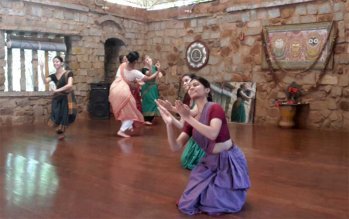
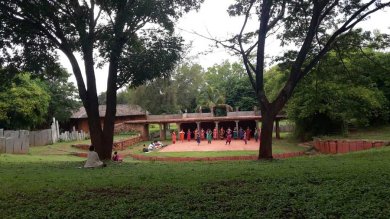
Rehearsals at Nrityagram
Photos: Sunil Kothari They have introduced utplavanas, jumps, have extended movements of arms, created solid basic positions of chauka, tribhanga, bhramaris and one notices the saushthava, the erect standing, correct position of the body, the strength, along with grace. Both the tandava and the lasya elements find equal importance in their training. One can see, in the sculptural quality of dance, the sensuousness is proportionate and balanced. When choreographing new works, Surupa undertakes a detailed study of the text, be it Odiya or Sanskrit, with the help of Bijayini. Meticulous care is taken of the words used, their multiple meanings, and nuances, how they are articulated with music, rhythm, and time cycle. How they are expressed on face and how the body has to be in perfect sync, creating beauty within Indian aesthetics. It is further heightened by well chosen costumes, silver ornaments and to top it with excellent lighting by that ace light designer Lynne Fernandez, who multitasks in terms of organization, looking at the nitty gritty and running the institution, leaving complete free time to dancers to concentrate to practice and polish their dance. As an institution, Nrityagram has achieved a benchmark as it insists on excellence. Be it recitation of the Natyasastra shlokas, with viniyogas, or practice of the charis, the sthanakas, and related Natyasastra aspects, the attention paid to detail is admirable. And the final product is there for all to see. Watching the rehearsals I could see that until the group performed with complete coordination in terms of body positions, chauka and other basic movements, the choreographic work had to be repeated again and again till everything was perfect. The entries and exits had to be unencumbered and flawless. Surupa would supervise with tattukali, the stick in her hand, to keep rhythm, sitting with the musicians and watching that the movements were as visualized when the work was choreographed. If there were flaws or incorrect resolutions of movements, the entire piece had to be performed again till the desired result was achieved. For the annual event, four major works were presented at Sophia School's auditorium which has a large stage. During her stay in Bangalore, Surupa was a student there. Her mother also taught there. For past ten years, Surupa takes classes twice a week there teaching dancers from the city, who are unable to come to Nrityagram. The auditorium has a capacity of 1,800 people and the infrastructure is good for proper presentation with perfect acoustics and lighting system. Therefore with such a setting the choreographic works looked extremely pleasant.  Chauka 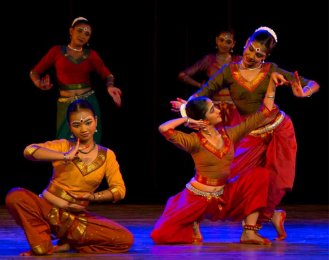 Uma putram 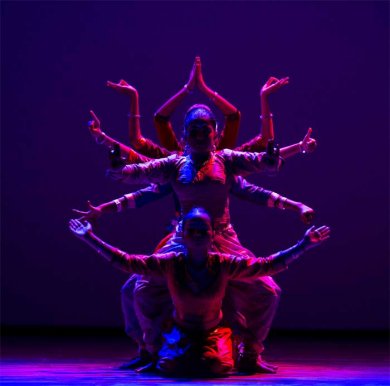 Mahavishnu astride Garuda 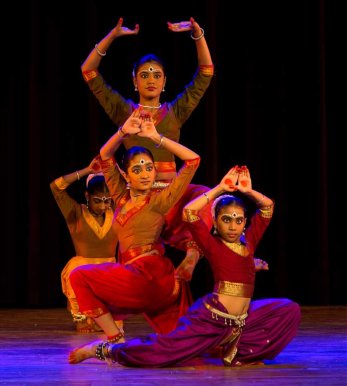 Tandavapriyaroopinam That Nrityagram has been imparting training free to village children on every Sunday is not known to people. On Sunday, children arrive from nearby and Surupa, Bijayini and Pavithra take their classes, including the shlokas for hastas and its viniyogas. There is a lot of fun and joy in the way the children learn. At the same time till the positions and movements are perfect, no further lessons are given. The enthusiasm is contagious. To showcase their group work, the prayer Namami Vighnaraja, in praise of Lord Ganapati was selected for the children. Divided into three groups, the group in the centre showed the lord astride his vehicle. The multiple arms imagery was captivating. On either side the devotees were praying in a row. With text Kalpavrikshatala sthitam, seated under the wish fulfilling tree, the dancers in cluster turned into the tree and with recitation of Uma putra, son of mother Uma, and the epithet Mahakaya, the few dancers grew in size, and the others seated on floor showed Ganapati's trunk and also eka danta, one tooth. Bhumi pranam followed with commendable control and coordination. Children were asked to have repeated rehearsals at the amphitheatre, and their perfect presentation naturally won rounds of applause. 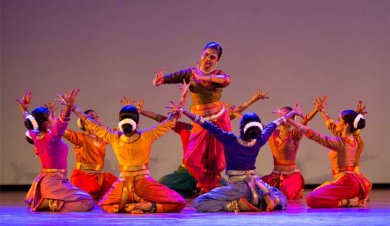 Jagannathaswamy nayana pathagami 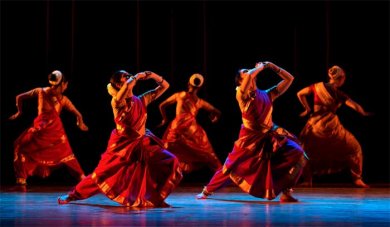 Sankirtanam Sankirtanam, a group composition choreographed by Surupa featured six major dancers, who have been resident at Nrityagram and involving the remaining 12 from the city, total of 18 dancers. There was a continuous flow of movements. Akshiti, a brilliant young dancer, with her immense energy enters the stage with jumps and executes, one after another, bhramaris and chauka, solid and full of strength. It is followed by other two dancers. With their entries the audience is already under the spell. The mardala articulates the ukutas and we see dancers playing pakhavaj with ecstasy, faces imbued with feelings of devotion, swaying with arms addressing Lord Jagannath. The background entry of dancers holding their chauka position creates an array of several icons of Jagannath. A striking visual. The narrative is enacted dramatically. The group performing the deeds of the lord, as one who protects the devotees, one who has subjugated Kaliya, the serpent, using the recitation like sabdaswarapata, the dancers performing combat with Kaliya and Krishna, then surrender by Kaliya, was performed with quicksilver quality. Dancing in frenzy, playing on khol and singing, the dancers transmit the audience to the temple where devotees are seen dancing as if in a trance. Surupa has created excellent choreography with so many nuances which with music echo in one's ears long after the dance is over. To share with audiences the language of hand gestures, a selection of hastas from Natyasastra is demonstrated by dancers in groups of threes and fours. The choreographic design of the hastas, commonly known as mudras, brings alive the images. Kartarimukha, Shikhara, Mushti, each with their meanings received good response. It was a good ploy to demystify the dance. The English translation helps to understand Sanskrit rendering. The piece de resistance was the choreographic work Sridevi. With Ayigiri Nandini prayer, the goddess who destroyed the demon Mahishasura is brought out by Surupa in a combat, the demon on floor surrounded by not one but four goddesses with trishul in their hands, one leg raised to trample his raised head. To describe Girinandini, daughter of Himalaya, the waving of index finger suchi creates a row of Himalayan peaks. Mahishasura being vanquished is a marvellous piece with goddesses' multiple forms. With description of Ramyakapardini shailasute, dancers turning their backs and moving towards the back of the stage makes excellent use of space. The finale with Bijayini and Pavithra incorporating Kamaladalamala prayer finds a felicitous expression in their dancing. The melodious singing describing the exquisite hair alikula, dark as bees, and bakulavali, delicate bakul flowers, creates the confluence of expression, poetry, and music, in aesthetic parlance, in a triveni sangam. The peaceful resolution of previous dynamic, vigorous presentation with the exquisite poetry is in a striking contrast. The flawless dancing by Bijayini and Pavithra leaves an indelible impression. The shanta rasa, the peace, repose is evoked movingly. Light designer Lynne colours them in gentle hues and the way the images slowly fade away looks just magical. To praise the high quality of dancing will be like gilding a lily. The mature approach of Surupa to the choreography, investing it with subtle nuances creating images, looks like when one tilts the kaleidoscope a little and sees an array of images. It is a special gift. It is visual poetry. It speaks volumes for Surupa's internalizing the art.  Dr. Sunil Kothari is a dance historian, scholar, author and critic. He is honored with Padma Shri, Sangeet Natak Akademi award and Senior Critic Award from Dance Critics Association, NYC. Post your comments Please provide your name and email id when you use the Anonymous profile in the blog to post a comment. All appropriate comments posted with name & email id in the blog will also be featured in the site. |